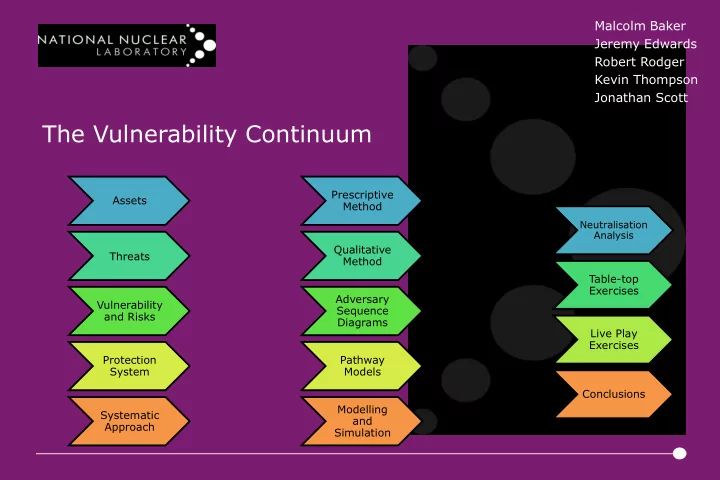

Malcolm Baker Jeremy Edwards Robert Rodger Kevin Thompson Jonathan Scott The Vulnerability Continuum Prescriptive Assets Method Neutralisation Analysis Qualitative Threats Method Table-top Exercises Adversary Vulnerability Sequence and Risks Diagrams Live Play Exercises Protection Pathway System Models Conclusions Modelling Systematic and Approach Simulation
Assets What are you trying to protect (what are the possible targets)? • People • Nuclear Material • Other Radioactive Materials • Structures, Systems and Components
Threats Design Basis Threat Potential Malicious Adversarial Scenarios Capabilities Forces
Vulnerability and Risks Adversary Response
Physical Protection System (PPS) • Designed to address vulnerabilities and manage risk • Assessment can be difficult Subjective • Many methods • • When is it “good enough?” Image Credit; Tom Olzak (TechRepublic)
Systematic Approach Information, Assessment, Decision and Process Categorise Assets for Theft and Sabotage Identify requirements for: Delay; Detect; Assess; Control of Access; and Insider Mitigation Design including Performance Specification Vulnerability Assessment
Prescriptive Methods Checklist approach (NSS11, Appendix 4) Very simple No expertise required Quick and Inexpensive Repeatable Image Credit; Wikimedia Commons Can include non-quantitative aspects (Security Management etc.) Χ No quantification Χ Is that equipment good enough? Χ No scoring – pass or fail “So you have a gate?”… Image Credit; Newgate UK
Qualitative Methods Software Questionnaire (Automated Questionnaire with scoring) Easy to use No expertise required Quick and Inexpensive Repeatable Can test non-quantitative aspects Image Credit; MISCW.com Χ Arbitrary quantification and scoring Χ Subjective (is that a 3 or a 4?)
Adversary Sequence Diagrams Customisable – can be simple or complex Quantifies Delay vs. Response Predominantly user driven Route comparison/assessment Understanding of PPS Image Credit; M. L. Garcia χ Data dependent χ No consideration of e.g. security management χ Transit delays difficult to reconcile χ Requires some expertise χ Takes longer than Prescriptive/Qualitative Image Credit; S Bassam
Pathway Methods Simple Pathway Customisable – can be simple or complex Quantifies Delay vs. Response Scenario based Route comparison/assessment Understanding of PPS χ Data dependent χ No consideration of e.g. security management χ Requires expertise χ Takes longer than Image Credit; IAEA NUSAM Prescriptive/Qualitative
Modelling and Simulation Image Credit; Ares Corp Pathway/Scenario Tools (e.g. AVERT, Simajin) Detailed pathway analysis Highly quantitative Thorough assessment of PPS Repeatable Modifiable Χ Expensive Χ Time consuming Χ Requires significant expertise Χ Needs high volume of data Χ No qualitative assessment Image Credit; Rhinocorps
Neutralisation analysis (ConOps) Customisable – can be simple or complex Specialist input Consideration of expected human responses Consideration of security management Understanding of PPS χ Potential for confirmation bias χ Requires significant expertise and knowledge χ Rarely accounts for human error
Table-top Exercises Customisable – can be simple or complex Specialist input Some consideration of expected human responses Some consideration of security management Understanding of PPS and response force Easily re-run χ Potential for confirmation bias χ Requires some expertise and knowledge χ Rarely accounts for human error χ Force on Force interactions may benefit first action
Live Play Exercises Customisable – can be simple or complex Specialist input Consideration of expected human responses Consideration of security management Understanding of PPS and response χ Expensive to organise and run χ Potential for confirmation bias χ Requires significant expertise and knowledge χ Limited repeatability
Conclusions There are many ways to assess the performance of Physical Protection Systems Each has their own strengths (cost, scope, schedule, detail) but also their own weaknesses (depth, coverage, completeness) Some require considerable investment in preparation for the assessment to maximise the value of the output No individual method will be all encompassing No method will ENSURE that the system will perform as expected when challenged for ‘Real’
Recommend
More recommend